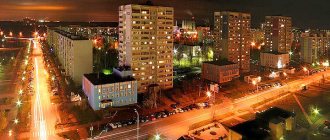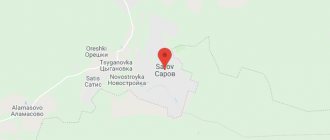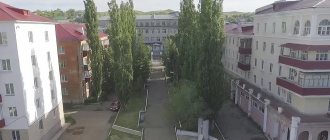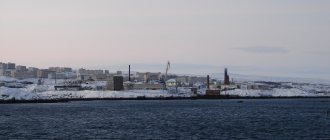One of the closed cities in Russia, the city of Snezhinsk in the Chelyabinsk region has had the status of a city since 1993. Snezhinsk residents live under a special regime for security reasons.
| Date of foundation | 1955 |
| Other names | Kasli-2, Chelyabinsk-50, Chelyabinsk-70 |
| Officially a city | Since 1993 |
| Mayor | Saprykin I.I. |
| Population | 50,759 people |
History and facts of Snezhinsk
Snezhinsk, Chelyabinsk region, is a closed city, founded in 1957 to establish a center for the development of the nuclear industry.
Snezhinsk, Chelyabinsk region, is a closed city that was founded to establish a center for the development of the nuclear industry.
After allocating the territory for the center, district No. 10 was created in 1955. The construction was carried out by military and construction units; no prisoners were taken into custody. Residential settlements were built for the families of military builders, military personnel and civilians. In 1955 – 1956, roads and railways were built at an accelerated pace.
In 1955, 2 schools for fifty students were commissioned, in 1957 - a kindergarten - a nursery for 125 children. Until 1980, dormitories, a bakery, food and grocery stores, a bathhouse, preschool institutions, hospitals, a maternity hospital and other infrastructure were built.
The closed city of Snezhinsk is interesting for its openness. The Komsomolskaya Pravda newspaper published an article about this city, its residents and development, ongoing international meetings between Britain and the Russian Federation, and the participation of schoolchildren in the World Olympiads. The city is visited by famous artists and people of art.
Other regions of the Urals
Mizhgorye
Author of the photo: Maria Shulzhenko
A small town located in the Ural Mountains at the foot of the mysterious Mount Yamantau , in the Republic of Bashkortostan . If in most closed cities the main reason for obtaining secrecy status is clear from the names of their city-forming enterprises, then in Mezhgorye this very enterprise is the Federal State Unitary Enterprise “ Construction Administration No. 30 ”. And it does not explain at all what is so secret hiding behind the walls of the checkpoint.
On the site of modern Mezhgorye there was everything and no matter what it was called - a village, a town, a special settlement, and a city. The first village standing here was called Ilmyash , then there was Tatly , then Kuzyelga , Ufa-105 , Solnechny , Beloretsk-15 , Beloretsk-16 and, finally, Mezhgorye . It was awarded the status of a closed city in 1995.
Village Komarovsky
The appearance of the village in the Orenburg region was due to the construction on this territory of military unit 68545 , redeployed from the city of Vladimir in 1964. , the 13th Missile Division was formed here .
Since 1979, the military town began to be called the urban-type settlement Dombarovsky-3 . The military garrison still retains this name. But the village received a new name and status in 1994, and the name was given in honor of cosmonaut V. M. Komarov the Orenburg region .
Until recently, the villages of Zvezdny ( Perm Territory ) and Lokomotivny ( Chelyabinsk Region ) could be added to this list. However, they have now been deprived of the status of a closed city - now anyone can visit them.
How to get into the city
Snezhinsk is located at the same distance from Chelyabinsk and Yekaterinburg. You can get from them to the closed city by car or bus, since there is a bus station in Snezhinsk. Distance – 128 km, travel time – 1 hour 30 minutes.
Since the city is closed, you can only enter it through checkpoints.
There is a procedure for entering the territory for different categories of citizens. In 2013, changes were made that did not affect residents of Snezhinsk. Close relatives have the right to visit the city more than once. A special commission makes decisions on entry for distant relatives. Foreign relatives (except brothers and sisters) are allowed entry only upon application from a city resident.
People with temporary registration live and work in Snezhinsk. There are other cases when the commission makes an exception: visiting a cemetery where relatives are buried or the anniversary of the school where a former resident of Snezhinsk studied.
Stadium named after Gagarin, FOC "Iceberg"
The Gagarin Stadium is the center of sports life in the city. The stadium has two football fields, courts for various sports, basketball and volleyball courts. The stadium area is surrounded by greenery, where adults and children love to spend time.
In 2008, an indoor ice skating rink “Iceberg” appeared in the city; now you can go ice skating even in the summer.
Natural attractions
The city of Snezhinsk, located in the Chelyabinsk region, has a unique beautiful nature.
The forest area of the city has sights of archaeological and biological value:
- Lake Sinara.
- Shaitan - Stone.
- Vyazovka River.
- Quarry for the extraction of building stone.
- Cape Cockerel.
- Cordon “7 Keys”.
- Mount Lysaya.
- Arboretum.
- Old pine.
Features of attractions:
- Lake Sinara – a favorite place for residents, especially in the summer, to enjoy nature and coolness. Trees occupy most of the shore, but here you can sunbathe, ride a yacht, boat, or go fishing. A playground has been built for children.
- The Vyazovka River is unusual for the trees and elms growing in it. They are not found in the forests of the region. The banks of the river are in swamps, but there are also convenient descents to the water. The place is picturesque, rich in flora and fauna, including plants listed in the Red Book.
- The quarry for the extraction of building stone is the same age as and the basis of the city. Located next to the entrance to the city, Checkpoint No. 2. Trees grow in the quarry, mice and chipmunks live. The quarry is used for industrial purposes: the stone is blasted and crushed stone is extracted.
- Cape Cockerel (the official name is Nebaskoy - ugly, unsightly) is located on Lake Sinara. From a distance, the shape of the cape resembles the head of a rooster. The place is picturesque and offers stunning views of the lake.
- In 1957, at the “7 Keys” cordon there was a forester’s house. Now this is a popular place among residents of Snezhinsk: newlyweds often come here on their wedding day. There are more than 10 keys on the cordon. The water is clean, cool, and attracts local animals to drink. Snezhin residents often collect water from springs.
- Mount Lysaya got its name due to the lack of trees on the slope facing the city. The townspeople go cross-country and downhill skiing or simply walk along the ridge of the cliff (400 m long).
- The arboretum was founded in the early 2000s. When the site was founded, more than 50 species of plants and shrubs were planted, brought from Moscow and provided by city residents. The arboretum was created for the purpose of studying plants and as a natural resting place. Pines, spruces, linden, rose hips, barberries and other trees grow favorably on the site. Birds and insects create a special microclimate. Now the arboretum requires special care, laying paths, arranging plants, but despite its unkempt appearance it is a favorite place for the residents of Snezhinsk.
- Shaitan – The stone rises in Lake Itkul 20 m from the shore. The famous author of fairy tales, Bazhov, described this natural monument in his works.
- At the entrance to the Snezhinsky Park of Culture and Recreation there is a pine tree, which, according to experts from Nizhny Novgorod, is 300 years old. The tree with a thick trunk and dense green crown is the oldest in the region. It survived the fire, and the crack in the tree did not affect its condition in any way: the resin has a healing effect. The pine tree is a real attraction; people often take pictures near it.
Lake Sinara
Sinara is the most beautiful place in the city, where it is so good to enjoy the beauty of nature. The lake pleases residents of Snezhinsk with picturesque views both in winter and summer. Basically, the coastal strip is covered with forest. People go fishing and boating on the lake.
The entire summer life of the city centers on the sandy beach of Sinara. There are playgrounds for children. You can play beach volleyball and just sunbathe. There are also several so-called “wild” beaches with rocky shores. There is also a local yacht club on the banks of the Sinara.
Squares and streets
Main streets of Snezhinsk:
- st. Vasilyeva;
- st. Lenin;
- st. Dzerzhinsky;
- st. Zababakhina;
- st. Mira;
- st. 40th anniversary of October;
- st. Zakharenkova.
Peculiarities:
- 40th Anniversary of October Street - the first street, since the first house was inhabited during the celebration of the revolution. On this street, the houses are located on one side, facing the lake, so they have both even and odd numbers.
- Lenin, Pobeda streets, Tsiolkovsky and Sverdlov boulevards lead to Lake Sinara.
- On the street Grechishnikov there is a cottage community. The houses have one floor and are designed for 2 owners. It was built for specialists from the Research Institute - 1011.
- Prospekt Mira (eastern part of Snezhinsk) is a separate urban area with its own developed infrastructure. A tall building of 16 floors on the corner of Zababakhina and Mira streets is the main symbol of the modern area.
Snezhinsk, Chelyabinsk region, is a city that does not have a large number of areas. Lenin Square and Victory Square are the main ones in the city. The latter is located on the corner of Victory and 40th Anniversary of October streets, founded in honor of the victory in 1945.
The main one is Lenin Square.
In the center there is a pedestal for the leader of the proletariat. Important events take place on the square: the Victory Day parade, the graduates' waltz. The city administration, post office, hotel, and Palace of Culture are located here.
Content
- 1 VNIITF
- 2 Geography
- 3 History
- 4 Population
- 5 Education 5.1 General and secondary education
- 5.2 Additional education
- 5.3 Higher education
- 11.1 Structure of local governments
- 12.1 Transport
Museums
The Nuclear Weapons Museum presents developments in the nuclear industry. The initiator of the creation of such a museum was A.D. Zakharenkov. At first the museum was secret, but later some of the exhibits were allocated for display. The museum has been operating since 1992. Some of the exhibits are presented that characterize the activities of the Institute of Nuclear Industry.
The Snezhinsky City Museum displays more than 10 thousand general and scientific exhibits. The museum was opened in 1996. The collected materials tell about the history of the city and region, nature and wildlife.
The museum conducts excursions around the city, cooperates with schools, the media, and cultural and educational institutions. Practical genealogy classes are held twice a year.
Politics[ | ]
Structure of local governments[ | ]
- The meeting of deputies of the city of Snezhinsk is a representative body of local government of the municipality;
- the head of the city of Snezhinsk is the highest official of the municipality;
- the administration of the city of Snezhinsk is the executive and administrative body of the municipality;
- The Chamber of Control and Accounts of the city of Snezhinsk is the control body of the municipality.
Head of the city of Snezhinsk[ | ]
From 1991 to 1996 - Vladimir Shchukin. Removed from office.
From 1996 to March 2005 - Anatoly Oplanchuk. Sentenced to 8 years in prison for receiving a large bribe, embezzlement and abuse of power. In 2011, the preventive measure was changed to correctional labor[25].
From March 25, 2005 to 2012 - Mikhail Evgenievich Zheleznov. Deputy Director of the Russian Federal Nuclear Center - All-Russian Scientific Research Institute of Technical Physics. According to the city election commission, more than 51.8% of the townspeople voted for him out of 23% who came to the elections.
From 2012-2016 A. N. Timoshenkov. On November 14, 2016, he was released from his position at his own request. O.P. Karpov was appointed acting Head.
Since December 2016, I. I. Saprykin became the Head of the Snezhinsky urban district.
Monuments
Several monuments to famous personalities have been erected in Snezhinsk, as well as in honor of significant dates.
Monuments:
- V. I. Lenin.
- Warrior-liberator.
- To the Snezhinsky soldiers who died in local conflicts.
- Kurchatov.
- K. I. Shchelkin.
- D. E. Vasiliev.
- P.I. Tchaikovsky.
Peculiarities:
- The monument to Lenin is located on the square. Lenin; installed on the 100th anniversary of his birth.
- Monument to the Warrior – the liberator was established on the 40th anniversary of the victory in the 1945 war.
- The monument to Kurchatov is located on the territory of the institute; Tchaikovsky - at the music school.
Commemorative plaques are installed on the houses where famous scientists lived - Shchelkin, Zababakhin, Feoktistov and others.
Population[ | ]
| Population | |||||||
| 1996[5] | 2000[5] | 2001[5] | 2002[6] | 2003[5] | 2005[5] | 2006[5] | 2007[5] |
| 47 900 | ↗48 600 | →48 600 | ↗50 451 | ↗50 500 | →50 500 | ↘50 400 | ↘50 200 |
| 2008[5] | 2009[7] | 2010[8] | 2011[5] | 2012[9] | 2013[10] | 2014[11] | 2015[12] |
| ↘50 100 | ↗50 106 | ↘48 810 | ↘48 800 | ↗48 899 | ↗49 116 | ↗49 475 | ↗49 746 |
| 2016[13] | 2017[14] | 2018[15] | 2019[16] | 2020[1] | |||
| ↗50 323 | ↗50 759 | ↗51 048 | ↗51 488 | ↗51 751 | |||
As of January 1, 2022, in terms of population, the city was in 313th place out of 1116[17]cities of the Russian Federation[18].
Houses on Victory Street
According to the census, the gender composition of the city's population is: 48.1% are men and 51.9% are women.
Temple and chapel
Snezhinsk, Chelyabinsk region, is a city whose residents are aimed at creating nuclear weapons in order to maintain the defense of the state. Therefore, for a long time, churches and temples were not given attention and funds. Parents instilled in their children the benefits of education and raised them outside of God.
In the early 90s of the 20th century, a small chapel made of wood in the shade of pine trees was built at the local cemetery. Wood carvers worked on the construction, and members of the housing and communal services donated funds. In the spring and summer, the Divine Liturgy is served here, prayers and memorial services are held, and parents' Saturdays are held.
In the village of Voskresensky, near Snezhinsk, in a dilapidated stone building near an abandoned church, a group of believers began the creation of the Church of the Icon of the Mother of God “The Sign”. The Mother of God showed this image to the Russian people on the day of the abdication of Tsar Nicholas II.
In 2013, electricity was installed in the church, and now services and other church events are held all year round.
Notes[ | ]
- ↑ 12
Population of the Russian Federation by municipalities as of January 1, 2022 (Russian). Date accessed: October 17, 2022. Archived October 17, 2022. - Order of the Government of the Russian Federation of July 29, 2014 No. 1398-r “On approval of the list of single-industry towns”
- Russian Federal Nuclear Center - All-Russian Research Institute of Technical Physics named after. Academician E.I. Zababakhin, Snezhinsk, Chelyabinsk region, Russia
- Rotunda on the shore
- ↑ 123456789
People's encyclopedia "My City". Snezhinsk - All-Russian population census 2002. Volume. 1, table 4. Population of Russia, federal districts, constituent entities of the Russian Federation, districts, urban settlements, rural settlements - regional centers and rural settlements with a population of 3 thousand or more (unspecified)
. Archived from the original on February 3, 2012. - The size of the permanent population of the Russian Federation by cities, urban-type settlements and regions as of January 1, 2009 (unspecified)
. Retrieved January 2, 2014. Archived January 2, 2014. - Volumes of the official publication of the results of the 2010 All-Russian Population Census for the Chelyabinsk Region. Volume 1. “Number and distribution of the population of the Chelyabinsk region.” Table 11 (undefined)
. Chelyabinskstat. Access date: February 13, 2014. Archived February 13, 2014. - Population of the Russian Federation by municipalities. Table 35. Estimated resident population as of January 1, 2012 (unspecified)
. Retrieved May 31, 2014. Archived May 31, 2014. - Population of the Russian Federation by municipalities as of January 1, 2013. - M.: Federal State Statistics Service Rosstat, 2013. - 528 p. (Table 33. Population of urban districts, municipal districts, urban and rural settlements, urban settlements, rural settlements) (undefined)
. Retrieved November 16, 2013. Archived November 16, 2013. - Table 33. Population of the Russian Federation by municipalities as of January 1, 2014 (unspecified)
. Access date: August 2, 2014. Archived August 2, 2014. - Population of the Russian Federation by municipalities as of January 1, 2015 (unspecified)
. Access date: August 6, 2015. Archived August 6, 2015. - Population of the Russian Federation by municipalities as of January 1, 2016 (Russian) (October 5, 2018). Retrieved May 15, 2022. Archived May 8, 2022.
- Population of the Russian Federation by municipalities as of January 1, 2022 (Russian) (July 31, 2017). Retrieved July 31, 2022. Archived July 31, 2022.
- Population of the Russian Federation by municipalities as of January 1, 2022 (Russian). Retrieved July 25, 2018. Archived July 26, 2022.
- Population of the Russian Federation by municipalities as of January 1, 2022 (Russian). Retrieved July 31, 2019. Archived May 2, 2022.
- taking into account the cities of Crimea
- https://rosstat.gov.ru/storage/mediabank/bul_Chislen_nasel_MO-01-01-2021.rar Population of the Russian Federation by municipalities as of January 1, 2022 (1.85 Mb, 07/30/2021)
- Snezhinsky city information portal (unspecified)
(inaccessible link). Access date: August 28, 2009. Archived February 1, 2012. - Honorary citizens of Snezhinsk
- Museum of Nuclear Weapons in Snezhinsk
- The chief engineer of the project, M.I. Pishcherov, managed, as a conductor, to take into account all the recommendations and requirements expressed during the design process, link them with strict standards and ensure the creation of a project for the institute and the city that would satisfy future generations. (unspecified)
(inaccessible link). Access date: June 8, 2014. Archived July 14, 2014. - Quiet alleys
- We are building a temple
- Ex-mayor of Snezhinsk Anatoly Oplanchuk left the colony - Online news - News
- Cellular operators in Snezhinsk (unspecified)
.
snezhinsk.spravker.ru
. Date accessed: December 14, 2022. - Sales offices and Yota coverage area in Russia - Addresses of communication stores (unspecified)
.
www.yota.ru.
_ Date accessed: December 14, 2022. - This settlement is located on the territory of the Crimean Peninsula, most of which is the subject of territorial disputes between Russia, which controls the disputed territory, and Ukraine, within whose borders the disputed territory is located, recognized by the majority of UN member states. According to the federal structure of Russia, on the disputed territory of Crimea there are constituent entities of the Russian Federation - the Republic of Crimea and the federal city of Sevastopol. According to the administrative division of Ukraine, on the disputed territory of Crimea there are regions of Ukraine - the Autonomous Republic of Crimea and the city with a special status of Sevastopol.
Military unit
Military unit 3468 of Snezhinsk is not much different from other military units in Russia. A distinctive feature is ensuring the safety of the city-forming enterprise. Employees guard the city perimeter, secret facilities, and carry out access control. There are 7 outposts along the perimeter of the city.
Each soldier has his own sleeping place and a place to store personal belongings. Since the city is closed, only parents are invited to the oath. Lists for issuing passes are drawn up in advance.
Snezhinsk is a scientific center of the Chelyabinsk region; a city with its own history, traditions and foundations. More than one generation of the greatest minds has grown up here, lives and works for the development of the country's nuclear industry.
Author: Victoria Alexandrovna (viktoriya_91)
Article design: Oleg Lozinsky







